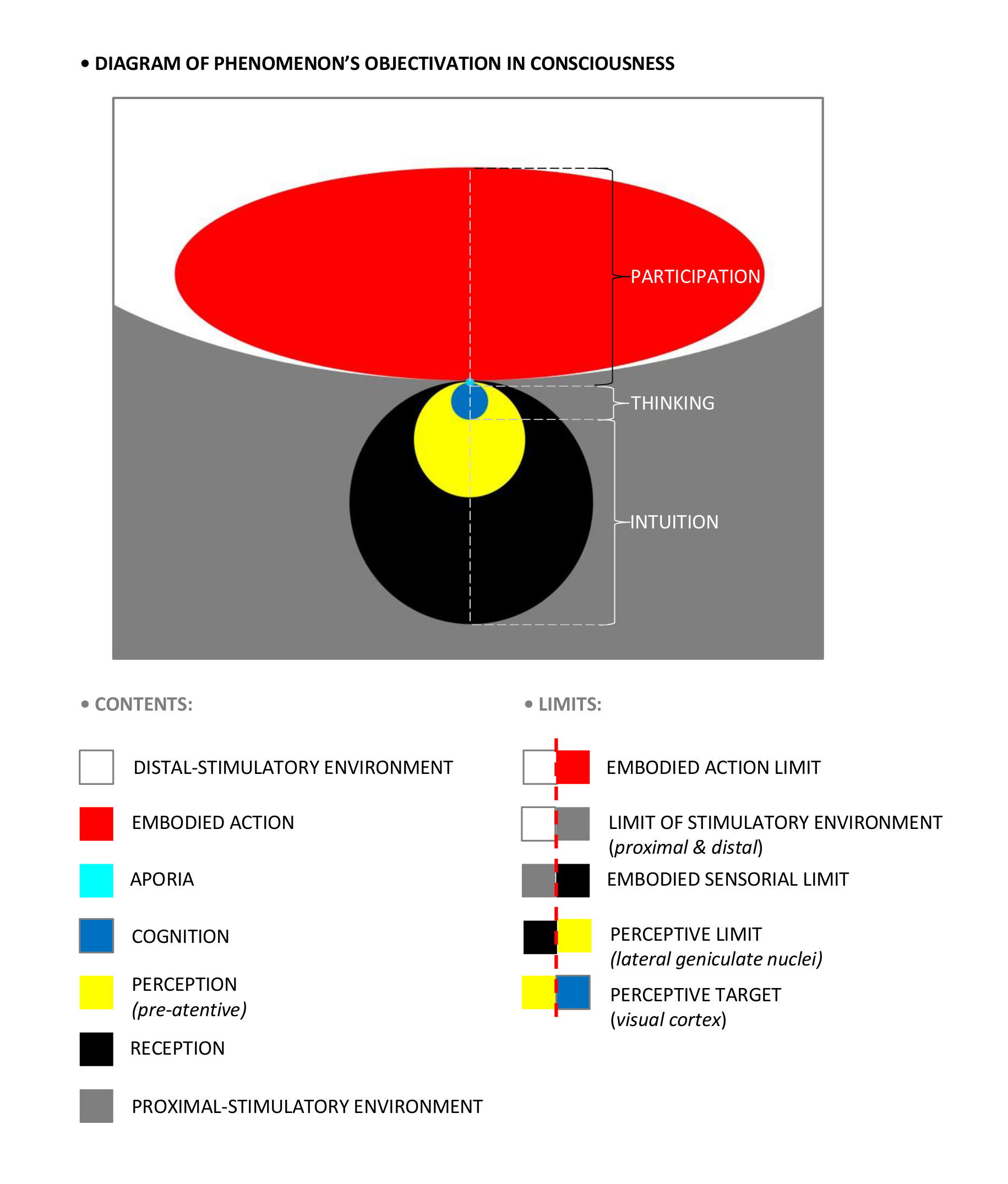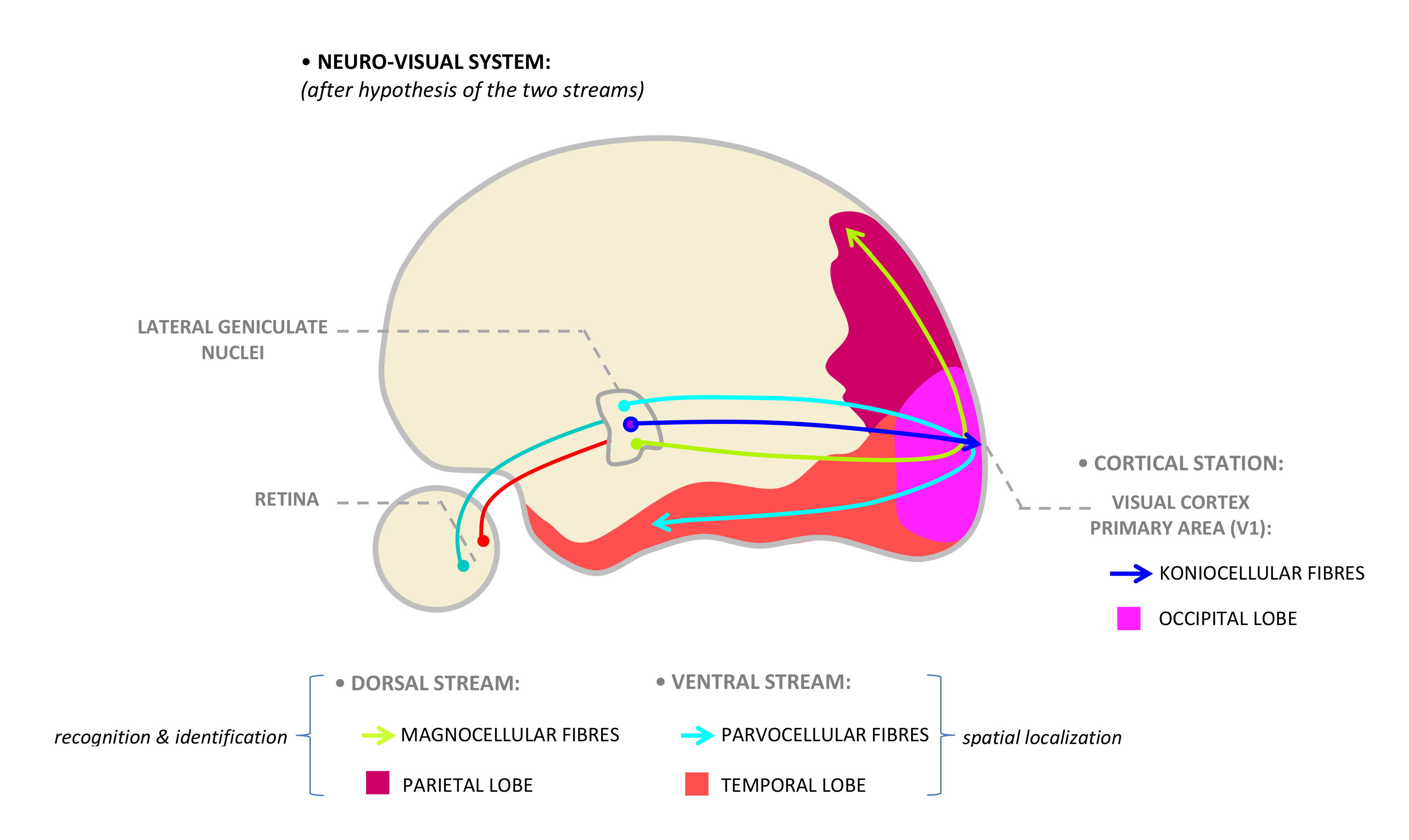WHAT WAS HE THINKING?

Some persistent questions pop up in the activity of structural researchers of works of visual art. They touch upon the objectivity of correspondence between his thoughts and those of the AUTHOR of the studied artwork. Are his thoughts in accord with those of the AUTHOR? Did he deviate from the concerns of the AUTHOR? Is he objective and independent of his stereotypes and biases of structural thinking?
The researcher can answer these questions using the principles of structural PHENOMENOLOGY or ONTOLOGY of works of visual art. He has to accept the communicative role of the VIEWER, with his need for artistic thoroughness. So in the following, the VIEWER is synonymous with the RESEARCHER of visual works of art. Also, when we refer to the PHENOMENON, we will consider the PHENOMENON of visual CREATION from a structural point of view.
Objectivation is the achievement of the phenomenon’s certitude in human consciousness, independent from subjective impressions of individuals involved in the process of CREATION. It is opposed to objectualisation which involves pretending a false concretization of the visual-artistic phenomenon, independent of human consciousness. The objectivation of the visual-artistic phenomenon is achieved by following three steps:
1) INTUITION or sensing;
2) THINKING or conceptualization;
3) LIVED EXPERIENCE or participation.

INTUITION involves the manifestation of PHENOMENON within CONSCIOUSNESS through senses, at SENSORIAL LEVEL, and within the cultural-artistic ambiance, as vague-affective involvement. Verbally, it manifests by a particular lyrical expression, not by descriptive exactness or morphological precision to decide the lucrative act. It is a stage of the diffuse aesthetic search, where appear impulses of certainty beyond pleasure or rejection. The incompleteness of conceptual instruments does not offer relational clarity but inconstancy and hesitation within the unifying meaning of participation.
The cultural-artistic dialog between the AUTHOR and VIEWER is free but not liberating because INTUITION implies a high potential for conceptual approach and constructive modeling. Without criteria of organization and relationship, the problems cannot receive a satisfying answer, and we cannot unify the relations. The access to the context is inaccessible.
Within communication between the AUTHOR and VIEWER can appear a false notion: the SECRET of CREATION, due to the advancement of thinking vagueness to the status of the basic rule. The SECRET creates inequity of dialog between the two partners because it belongs only to the AUTHOR. The VIEWER has access only to scattered landmarks and arbitrary ways of interpretation in a never-ending spiral of combinations of relational possibilities. Also, we mistakenly identify this lack of unity and organization with CREATIVITY and play, which are so easy to confuse or overestimate against CREATION. CREATIVITY has to remain only training for CREATION, even if it opens potential phenomenal horizons in the structural preparation of artworks.
THINKING involves the manifestation of PHENOMENON within CONSCIOUSNESS at the PERCEPTIVE and COGNITIVE LEVEL of spatial organization. The perceptive targets, neuro-combinatorial synthesized at the CORTICAL LEVEL, are contextualized within COGNITIVE MAPS of working and long-term memory. Here PROPERTIES develop as conceptual-notional landmarks along the VENTRAL and DORSAL STREAMS. They connect to perform the decision of motor-lucrative action in a unifying thinking process named REDUCTION.

The usual THINKING operations applied in solving problems – DEDUCTION and INDUCTION – do not support the unifying and reductive nature of phenomenological THINKING. The REDUCTION implies ABDUCTIVE operationalization that helps select a set of filtered observations and synthesized categories as the most likely emerged conclusion.
In structural research, ABDUCTION implies three operational stages:
1) ANALYSIS offers the imagistic information cartographically filtered and constructively disassembled before relating properties;
2) SYNTHESIS implies relating the analytical landmarks of structural properties as categories;
3) ESSENTIALISATION implies the simplification or REDUCTION of multiple possibilities of relations based on similarity, opposition, and ATTENTIVE order of priority to two morphological components: BACKGROUND and OBJECT, with the uprising of the OBJECT.
We see that the ABSTRACTION is realized by REDUCTION as the ESSENTIALISATION of SYNTHESIS, not of ANALYSIS, and opposed to intuitive generalization. It is evident that the notion of ABSTRACTION associated with non-figurative images of geometric or gestural type is inappropriate. ABSTRACTISATION is the horizon of ESSENTIALIZATION of REDUCTION of any constructive resolution, including the figurative representation.
LIVED EXPERIENCE overcomes or transcends the REDUCTION of PHENOMENON by action in the CONSCIOUSNESS of the AUTHOR and initiates a new PHENOMENON in the CONSCIOUSNESS of the VIEWER.
As I said, the limitation of INTUITION in AUTHOR-VIEWER communication is the false SECRET of CREATION assigned by the VIEWER to the AUTHOR. By this, the VIEWER must accept only scattered information from the feast of artistic knowledge and hope for his spiritual fulfillment through multiple, discontinuous, and speculative interpretations. Communicational alienation comes from a wrong understanding of the status of the AUTHOR and VIEWER. Both the AUTHOR and the VIEWER have the same status facing the horizon of CREATION. Both experience in equal amounts the act of CREATION. The gap does not refer to their engagement in CREATION but to the stages of the CREATION process as follows:
• The AUTHOR involves himself by INTUITION and action within the LIVED EXPERIENCE;
• The VIEWER involves himself by INTUITION and REDUCTION, driven by the IMPULSE of the AUTHOR, which leads the VIEWER to his own decision of artistic action within the LIVED EXPERIENCE.
• The AUTHOR is also a VIEWER along the stages of the working process.
Therefore we see that the LIVED EXPERIENCE is the fulfillment of INTUITION by action, not by THINKING, as a result of REDUCTION. However, even though the REDUCTION looks like a bridge between THINKING and LIVING EXPERIENCE, there is a profound and insurmountable gap between them that involves the state of APORIA – detachment and canceling of THINKING operations after REDUCTION. To attend the stage of APORIA, you do not have to directly give up THINKING, that is, to detach from THINKING artificially and voluntarily. In the pedagogical steps of the CREATION process, both the future AUTHOR and the future VIEWER must be guided and allowed to reach the NECESSITY of APORIA in an APODICTIC way – following the unique path of CREATION by unifying the structural relations in REDUCTION. Also, APORIA is compatible with ABDUCTION because REDUCTION does not involve inductive causation and deducted effect. Instead, we have connective cause and reasonable effect that emerges independent of the will, anticipation, and immediate operational predictability. ABDUCTION sustains the SPONTANEITY of ESSENTIALIZATION in ABSTRACTION.
The display of artistic visual PHENOMENON is possible due to the AUTHOR - which is not the absolute source of the PHENOMENON. The AUTHOR is just a link in a flux of cultural and spiritual PHENOMENA belonging to his eco-social community. The spiritual intuitions and lucrative actions of the AUTHOR are within the horizon of his CREATION. The VIEWER is himself an AUTHOR that has access to the horizon of CREATION through the artwork of the AUTHOR, not by the AUTHOR in a direct way but because of his abnegation. In his need for relational objectivity, the VIEWER must avoid interposing the personalist individuality of the AUTHOR between his CONSCIOUSNESS and CREATION. It would result in an artificially objectualized PHENOMENON or an inaccessible NUMEN. We cannot objectualize CREATION because it manifests as a horizon of INTUITION and LIVED EXPERIENCE, not as external finality and not as an instrument of THINKING.
The objective communication between the AUTHOR and VIEWER is only interpersonal – not personalist-individual – within the horizon of CREATION, not of the object of art.
In conclusion, the match between the AUTHOR’s and the VIEWER’s thoughts doesn’t matter. The purpose is to arrive at a mutual decision of lucrative activation beyond the operational THINKING respective to the spiritual impulse of INTUITION and the unifying effect of the researcher’s THINKING.INTUITION and LIVED EXPERIENCE are the base of the act of CREATION, still the triggering of LIVED EXPERIENCE is achieved by the emergence of APORETIC discontinuity, not by replication of the AUTHOR’s THINKING by the VIEWER.
THINKING creates within CONSCIOUSNESS a maximal tension between the self-centered need of the human individual and the tendency of contextual eco-social integration by the interpersonal action of the two partners. CREATION happens only at the interpersonal level by transcending individual THINKING within unifying CONSCIOUSNESS of PHENOMENON. .